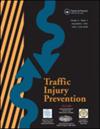倾斜撞击中多种可折叠儿童约束系统与儿童乘员之间的相互作用。
IF 1.9
3区 工程技术
Q3 PUBLIC, ENVIRONMENTAL & OCCUPATIONAL HEALTH
引用次数: 0
摘要
目的评估多个面向后方(RF)和面向前方(FF)CRS约束的儿童乘员在斜撞击中的动力学相互作用:方法:将一名 Q3s 和一名 Q1.5 ATD 儿童分别固定在标准(503 毫米)和超薄(425 毫米)两种不同宽度的 CRS 中,并将其固定在一辆 2023 年紧凑型轿车刚性后座长凳的两个后外侧座椅上。左外侧位置安装了一个代理车门结构。在所有测试中,Q1.5 采用 RF 配置,Q3s 采用 RF 或 FF 配置。ATD 的约束方式如下:(1)两个ATD均使用标准CRS,(2)两个ATD均使用超薄CRS,在外侧座椅之间切换,共8种情况。在第九次测试中,将后排座椅的中央扶手在 CRS 之间放下,再现了这些测试中头部动能指标最高的情况。使用 FMVSS 213 冲击脉冲对整个环境进行了 60° 斜撞击:坐在远侧时,Q3 的头部接触到附近的 CRS 外壳。坐在近侧时,Q3s 的头部在 4 种情况中的 1 种接触到代理车门结构。Q1.5 坐在远侧时,头部在 4 种情况中的 2 种接触到附近的 CRS。无论坐在远侧还是近侧位置,坐在射频位置的 Q3 均具有较高的 HIC15 和头部 3 毫秒夹加速度(H3ms)。坐在远侧时,Q3s 在 FF 配置下的上颈部拉力(Fz)(2,317.4 和 2,077.9 牛顿)高于 RF 配置下的上颈部拉力(1,850.8 和 1,802.8 牛顿)。当坐在近侧时,FF 配置下的相同值(701.3 和 1,029.4 牛顿)低于 RF 配置下的相同值(997.6 和 1,261.7 牛顿)。重复头部动力学指标最高的条件(HIC15 = 1246;H3ms = 114.4 g),但降低 CRS 之间的中央扶手会导致头部动力学指标降低(HIC15 = 916,H3ms = 93.5 g):在大多数情况下,远侧就座的 ATD 的头部会接触到近侧的 CRS 外壳,从而导致两种 CRS 中的伤害指标数值升高和负载增加。近侧的 ATD 没有受到远侧乘员和 CRS 相互作用的不利影响。本文章由计算机程序翻译,如有差异,请以英文原文为准。
Interaction between multiple convertible child restraint systems and pediatric occupants in oblique impacts
Objectives
To assess the interaction of multiple rearward-facing (RF) and forward-facing (FF) CRS restrained pediatric occupants on their kinetics in oblique impacts.
Methods
A Q3s and a Q1.5 ATD were restrained in 2 CRSs of varying widths—standard (503mm) and slim-fit (425mm)—in the 2 rear outboard seats of a 2023 compact sedan rigidized rear seat bench. A surrogate door structure was mounted at the left outboard location. The Q1.5 was seated in an RF configuration, and the Q3s was seated in RF or FF configurations across tests. The ATDs were restrained as follows: (1) both ATDs in standard CRSs and (2) both ATDs in slim-fit CRSs, switching between the outboard seats for a total of 8 conditions. The condition with the highest head kinetic metrics from these tests was reproduced in a ninth test with the rear seat’s center armrest lowered between CRSs. The entire environment was subjected to an oblique impact at 60° using the FMVSS 213 impact pulse.
Results
The Q3s’ head contacted the nearby CRS shell when seated farside. When seated nearside, the Q3s’ head contacted the surrogate door structure in 1 of 4 conditions. The Q1.5’s head contacted the nearby CRS in 2 of 4 conditions when seated farside. The Q3s when seated RF had higher HIC15 and head 3ms clip acceleration (H3ms), regardless of farside or nearside position. When seated farside, upper neck tensile force (Fz) for the Q3s in FF configuration (2,317.4 and 2,077.9 N) was higher than that in RF configuration (1,850.8 and 1,802.8 N). When seated nearside, the same in FF configuration (701.3 and 1,029.4 N) was lower than that in RF configuration (997.6 and 1,261.7 N). Repeating the condition with the highest head kinetic metrics (HIC15 = 1246; H3ms = 114.4 g) but lowering the center armrest between the CRSs resulted in lower head kinetic metrics (HIC15 = 916, H3ms = 93.5 g).
Conclusions
In most cases, the farside seated ATD’s head contacted the nearside CRS shell, resulting in elevated injury metric numbers and higher loading in both CRS types. The nearside ATD did not experience detrimental effects of the interaction with the farside occupant and CRS.
求助全文
通过发布文献求助,成功后即可免费获取论文全文。
去求助
来源期刊

Traffic Injury Prevention
PUBLIC, ENVIRONMENTAL & OCCUPATIONAL HEALTH-
CiteScore
3.60
自引率
10.00%
发文量
137
审稿时长
3 months
期刊介绍:
The purpose of Traffic Injury Prevention is to bridge the disciplines of medicine, engineering, public health and traffic safety in order to foster the science of traffic injury prevention. The archival journal focuses on research, interventions and evaluations within the areas of traffic safety, crash causation, injury prevention and treatment.
General topics within the journal''s scope are driver behavior, road infrastructure, emerging crash avoidance technologies, crash and injury epidemiology, alcohol and drugs, impact injury biomechanics, vehicle crashworthiness, occupant restraints, pedestrian safety, evaluation of interventions, economic consequences and emergency and clinical care with specific application to traffic injury prevention. The journal includes full length papers, review articles, case studies, brief technical notes and commentaries.
 求助内容:
求助内容: 应助结果提醒方式:
应助结果提醒方式:


